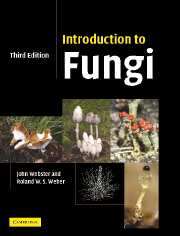Book contents
- Frontmatter
- Contents
- Preface to the first edition
- Preface to the second edition
- Preface to the third edition
- Acknowledgements
- 1 Introduction
- 2 Protozoa: Myxomycota (slime moulds)
- 3 Protozoa: Plasmodiophoromycota
- 4 Straminipila: minor fungal phyla
- 5 Straminipila: Oomycota
- 6 Chytridiomycota
- 7 Zygomycota
- 8 Ascomycota (ascomycetes)
- 9 Archiascomycetes
- 10 Hemiascomycetes
- 11 Plectomycetes
- 12 Hymenoascomycetes: Pyrenomycetes
- 13 Hymenoascomycetes: Erysiphales
- 14 Hymenoascomycetes: Pezizales (operculate discomycetes)
- 15 Hymenoascomycetes: Helotiales (inoperculate discomycetes)
- 16 Lichenized fungi (chiefly Hymenoascomycetes: Lecanorales)
- 17 Loculoascomycetes
- 18 Basidiomycota
- 19 Homobasidiomycetes
- 20 Homobasidiomycetes: gasteromycetes
- 21 Heterobasidiomycetes
- 22 Urediniomycetes: Uredinales (rust fungi)
- 23 Ustilaginomycetes: smut fungi and their allies
- 24 Basidiomycete yeasts
- 25 Anamorphic fungi (nematophagous and aquatic forms)
- References
- Index
- Plate section
23 - Ustilaginomycetes: smut fungi and their allies
- Frontmatter
- Contents
- Preface to the first edition
- Preface to the second edition
- Preface to the third edition
- Acknowledgements
- 1 Introduction
- 2 Protozoa: Myxomycota (slime moulds)
- 3 Protozoa: Plasmodiophoromycota
- 4 Straminipila: minor fungal phyla
- 5 Straminipila: Oomycota
- 6 Chytridiomycota
- 7 Zygomycota
- 8 Ascomycota (ascomycetes)
- 9 Archiascomycetes
- 10 Hemiascomycetes
- 11 Plectomycetes
- 12 Hymenoascomycetes: Pyrenomycetes
- 13 Hymenoascomycetes: Erysiphales
- 14 Hymenoascomycetes: Pezizales (operculate discomycetes)
- 15 Hymenoascomycetes: Helotiales (inoperculate discomycetes)
- 16 Lichenized fungi (chiefly Hymenoascomycetes: Lecanorales)
- 17 Loculoascomycetes
- 18 Basidiomycota
- 19 Homobasidiomycetes
- 20 Homobasidiomycetes: gasteromycetes
- 21 Heterobasidiomycetes
- 22 Urediniomycetes: Uredinales (rust fungi)
- 23 Ustilaginomycetes: smut fungi and their allies
- 24 Basidiomycete yeasts
- 25 Anamorphic fungi (nematophagous and aquatic forms)
- References
- Index
- Plate section
Summary
Ustilaginomycetes
The Ustilaginomycetes are one of the four main classes of Basidiomycota and contain about 1500 species (Kirk et al., 2001). In its present form as circumscribed by Begerow et al. (1997) and Bauer et al. (1997, 2001), this group is monophyletic. Hypha-producing Ustilaginomycetes are united by their lifestyle as ecologically obligate plant pathogens, often with an additional free-living (saprotrophic) yeast phase. They can be distinguished from the rust fungi in that haustoria are either altogether absent or, where present, take the shape of simple intracellular hyphae or hyphal extensions which invaginate the host plasmalemma but are not differentiated into a narrow neck and a wider haustorial body. Further, intracellular hyphae of Ustilaginomycetes usually secrete a thick sheath which is readily visible by transmission electron microscopy (see Figs. 23.6 and 23.17). The septa either lack perforations or contain simple pores or dolipores which are similar to those in the Urediniomycetes in lacking parenthesomes. True clamp connections are not usually found. The basidia of smut fungi produce numerous basidiospores whereas those of rust fungi usually produce only four.
The class Ustilaginomycetes has been divided into three subclasses by Begerow et al. (1997, 2000). We shall consider representatives of two of these. The Ustilaginomycetidae (Section 23.2) are the most important plant-pathogenic Ustilaginomycetes, causing smut-like symptoms. Typical members of the Exobasidiomycetidae (Section 23.4) cause other biotrophic diseases and are distinguished from the former by producing basidia directly from parasitic mycelium, not from teliospores.
- Type
- Chapter
- Information
- Introduction to Fungi , pp. 636 - 657Publisher: Cambridge University PressPrint publication year: 2007

